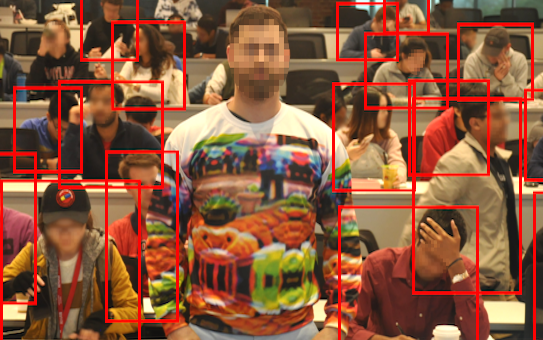Science Fiction
Dictionary
A B C D E F G H I J K L M N O P Q R S T U V W X Y Z
Adversarial Pattern Shirts Confound Object Detection Systems

Computers are getting way too good at identifying us (systems in China are taking masks into account).

(Bright adversarial pattern shirt)
It turns out, confounding software into not realizing what it's looking at is a matter of fooling several different smaller systems at once.Think about a person, for example. Now think of a person who looks nothing like that. And now do it again. Humanity, after all, contains multitudes, and a person can have many different appearances. A machine learning system needs to understand the diverse array of different inputs that, put together, mean "person." A nose by itself won't do it; an eye alone will not suffice; anything could have a mouth. But put dozens or hundreds of those priors together, and you've got enough for an object detector.
Code does not "think" in terms of facial features, the way a human does, but it does look for and classify features in its own way. To foil it, the "cloaks" need to interfere with most or all of those priors. Simply obscuring some of them is not enough. Facial recognition systems used in China, for example, have been trained to identify people who are wearing medical masks while trying to prevent the spread of COVID-19 or other illnesses.
And of course, to make the task even more challenging, different object detection frameworks all use different mechanisms to detect people, Goldstein explained. "We have different cloaks that are designed for different kinds of detectors, and they transfer across detectors, and so a cloak designed for one detector might also work on another detector," he said.
Science fiction writer Philip K. Dick, in his 1977 novel A Scanner Darkly, described a scramble suit, a device that enables the wearer to defy description, both in person and in surveillance videos:
(Explanatory Scramble suit video from the movie version)
The scramble suit was an invention of the Bell laboratories, conjured up by accident by an employee named S. A. Powers... Basically, his design consisted of a multifaceted quartz lens hooked up to a million and a half physiognomic fraction-representations of various people: men and women, children, with every variant encoded and then projected outward in all directions equally onto a superthin shroudlike membrane large enough to fit around an average human.
(Read more about Philip K. Dick's scramble suit)
I love this story, take a look at similar instances:
- Let's Hear It For The Vague Blur!
- Face Recognition Now Sees Through Disguises
- HyperFace Aims To Foil Facial Recognition
- Camouflage To Confound Face Recognition
- RealFace Glamoflage T-Shirt Like PKD's Scramble Suit
- CV Dazzle Anti-Surveillance Make-Up
- Project KOVR Fashion Protection From Infosphere
- Deep Learning Creates New Faces
Scroll down for more stories in the same category. (Story submitted 3/29/2020)
Follow this kind of news @Technovelgy.| Email | RSS | Blog It | Stumble | del.icio.us | Digg | Reddit |
Would
you like to contribute a story tip?
It's easy:
Get the URL of the story, and the related sf author, and add
it here.
Comment/Join discussion ( 0 )
Related News Stories - (" Surveillance ")
LingYuan Vehicle Roof Drones Now Available, ala Blade Runner 2049
Accompanied by a small selection of similar ideas from science fiction.
Chameleon Personalized Privacy Protection Mask
'...the Virtual Epiphantic Identity Lustre.' - Neal Stephenson, 2019.
Spherical Police Robot Rolls In China
'Rand could effectively be in several places at once...' - Niven and Pournelle, 1981.
Vietnam To Have Full Biometric Transparency
'inscriptions too small to be seen with the naked eye; microscopic data...' - Eric Frank Russell, 1939.
Technovelgy (that's tech-novel-gee!) is devoted to the creative science inventions and ideas of sf authors. Look for the Invention Category that interests you, the Glossary, the Invention Timeline, or see what's New.
Science Fiction
Timeline
1600-1899
1900-1939
1940's 1950's
1960's 1970's
1980's 1990's
2000's 2010's
Current News
iPhone Air Fulfils Jobs' Promise From 2007 - A Giant Screen!
'... oblongs were all over the floor and surfaces.'
ChatGPT Now Participates in Group Chats
'...the city was their laboratory in human psychology.'
iPhone Pocket All Sold Out!
'A long, strong, slender net...'
Did The Yautja Have These First?
What a marvel of ingenuity the little device was!
Jetson ONE Air Races Begin, Can Air Polo Be Far Behind?
'If you're one of those rarities who haven't attended a rocket-polo "carnage", let me tell you it's a colorful affair.'
Will Space Stations Have Large Interior Spaces Again?
'They filed clumsily into the battleroom, like children in a swimming pool for the first time, clinging to the handholds along the side.'
Mornine Sales Robot
'Robot-salesmen were everywhere, gesturing...'
Bipedal Robot Floats Gently While Walking
'a walking balloon proceeded with long strides of its aluminum legs...'
Musk Idea Of Cars Talking To Each Other Predicted 70 Years Ago
'My cars talk to one another.'
Elegant Bivouac Shelter Produces Water And Electricity
'There was nowhere on the planet where science and technology could not provide one with a comfortable home...'
X-Control Janus-1 A Suitcase Aircraft
'You will notice that it... fits the suitcase nicely.'
'AI Assistants' Are Actually Less Reliable For News
'Most men updated their PIP on New Year's Day...'
YES!! Remote Teleoperated Robots predicted by Technovelgy!
'...a misshapen, many-tentacled thing about twice the size of a man.'
Will Robots Ever Fold Landry?
Where have you gone, Mrs. Robinson?
Will AIs Give Better Results If You're Rude To Them?
'I said, "Listen up, motherf*cker.'
Cybertruck Robotic Arm F10 Drone Launch!
Drone away!
